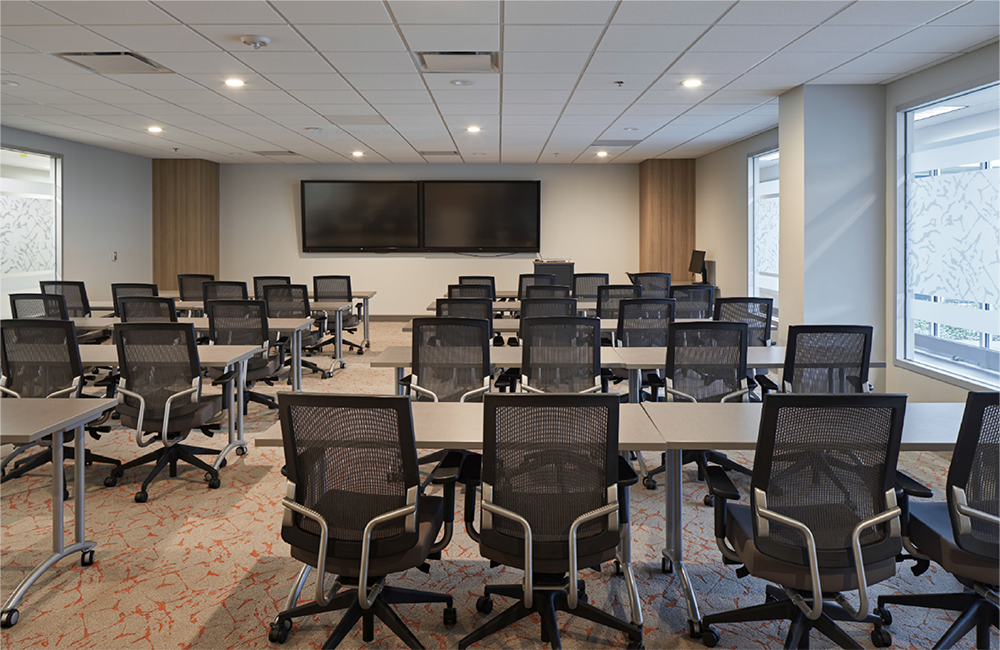If you’re looking to hire entry-level IT talent like Help Desk, Network Administrator or .NET Developers, our Career Services team offers free placement services, including exclusive IT Job Fairs showcasing our graduates. There’s no better way to discover and hire entry-level technology professionals.


Centriq Studios is a video as a service platform that provides a convenient, affordable video production suite to content creators. We provide everything needed to create a high-quality video that's ready for publishing.
The Centriq facilities offer spacious, state-of-the-art rooms with with tons of natural light to help boost performance. Customize a workspace to fit almost every type of training or meeting room needed. Centriq's room rentals provide a space you need to get to work with on-site tech support, modern amenities, convenient location and plenty of free parking. Our rooms are spacious, well equipped, have comfortable seating and feature bright display projectors and screens.


Centriq is an authorized testing center for certification testing vendors including Pearson VUE and RedHat. Schedule an exam in the Kansas City building and review the materials you need to bring with you.
Copyright © 2025 Centriq Training. All rights reserved
Start Date | End Date | Day/Eve | Break Weeks | Track |
|---|---|---|---|---|
Jan 23, 2023 | Jul 27, 2023 | Eve | 4/3/23-4/7/23 5/22/23-5/26/23 7/3/23-7/7/23 | CSSP-V |
Jan 30, 2023 | May 5, 2023 | Day | 3/6/23-3/10/23 4/10/23-4/14/23 | CSSP-V |
Feb 6, 2023 | May 19, 2023 | Day | 3/27/23-3/31/23 | FSCP-V |
Mar 20, 2023 | Jun 23, 2023 | Day | 4/24/23-4/28/23 5/22/23-5/26/23 | CSSP-V |
Apr 10, 2023 | Jul 28, 2023 | Day | 5/29/23-6/2/23 7/3/23-7/7/23 | FSCP-V |
Apr 24, 2023 | Oct 19, 2023 | Eve | 7/3/23-7/7/23 8/21/23-8/25/23 | CSSP-V |
May 15, 2023 | Dec 14, 2023 | Eve | 7/3/23-7/7/23 9/4/23-9/8/23 11/20/23-11/24/23 | FSCP-V |
Jun 5, 2023 | Sep 8, 2023 | Day | 7/3/23-7/7/23 8/7/23-8/11/23 | CSSP-V |
Jun 19, 2023 | Oct 6, 2023 | Day | 7/3/23-7/7/23 9/4/23-9/8/23 | FSCP-V |
Jul 24, 2023 | Jan 25, 2024 | Eve | 10/2/23-10/6/23 11/20/23-11/24/23 12/25/23-12/29/23 | CSSP-V |
Aug 14, 2023 | Nov 17, 2023 | Day | 9/5/23-9/8/23 10/16/23-10/2/23 | CSSP-V |
Aug 28, 2023 | Dec 15, 2023 | Day | 9/4/23-9/8/23 11/20/23-11/24/23 | FSCP-V |
Oct 30, 2023 | Feb 2, 2024 | Day | 11/20/23-11/24/23 12/25/23-12/29/23 | CSSP-V |
Oct 30, 2023 | May 2, 2024 | Eve | 11/20/23-11/23/23 3/4/23-3/7/23 | CSSP-V |
Nov 6, 2023 | Mar 1, 2024 | Day | 11/20/23-11/24/23 12/25/23-12/29/23 1/29/24-2/2/24 | FSCP-V |
Start Date | End Date | Day/Eve | Break Weeks | Track |
|---|---|---|---|---|
Feb 29, 2024 | Mar 24, 2024 | Day | 3/25/24-3/29/24 4/22/24-4/26/24 | CSSP-I |
May 13, 2024 | Aug 16, 2024 | Day | 5/27/24-5/31/24 7/1/24-7/5/24 | CSSP-I |
Aug 19, 2024 | Nov 22, 2024 | Day | 9/2/24-9/6/24 10/21/24-10/25/24 | CSSP-I |
Dec 2, 2024 | Mar 14, 2025 | Day | 12/23/24-12/27/24 12/30/24-1/3/25 2/10/25-2/14/25 | CSSP-I |
Start Date | End Date | Day/Eve | Break Weeks | Track |
|---|---|---|---|---|
Jan 13, 2025 | Apr 18, 2025 | Day | 2/17/25-2/21/25 3/17/25-3/21/25 | CSSP-I |
Feb 10, 2025 | Aug 14, 2025 | Eve | 3/24/25-3/27/25 5/26/25-5/29/25 6/30/25-7/4/25 | CSSP-I |
Feb 24, 2025 | Jun 6, 2025 | Day | 3/31/25-4/4/25 4/28/25-5/2/25 5/26/25-5/30/25 | CSSP-I |
Mar 31, 2025 | Jul 11, 2025 | Day | 5/5/25-5/9/25 5/26/25-5/30/25 6/30/25-7/4/25 | CSSP-I |
May 5, 2025 | Aug 8. 2025 | Day | 5/26/25-5/30/25 6/30/25-7/4/25 | CSSP-I |
Jun 9, 2025 | Sep 19, 2025 | Day | 6/30/25-7/4/25 8/4/25-8/8/25 9/1/25-9/5/25 | CSSP-I |
Jul 28, 2025 | Oct 31, 2025 | Day | 9/1/25-9/5/25 9/29/25-10/3/25 | CSSP-I |
Aug 18, 2025 | Feb 26, 2026 | Eve | 9/1/25-9/4/25 11/24/25-11/27/25 12/22/25-12/25/25 12/29/25-1/1/26 | CSSP-I |
Sep 8, 2025 | Dec 12, 2025 | Day | 10/13/25-10/17/25 11/24/25-11/28/25 | CSSP-I |
Oct 13, 2025 | Jan 23, 2026 | Day | 11/24/25-11/28/25 12/22/25-12/26/25 12/29/25-1/2/26 | CSSP-I |
Dec 1, 2025 | Mar 13, 2025 | Day | 12/22/25-12/26/25 12/29/25-1/2/26 2/9/26-2/13/26 | CSSP-I |